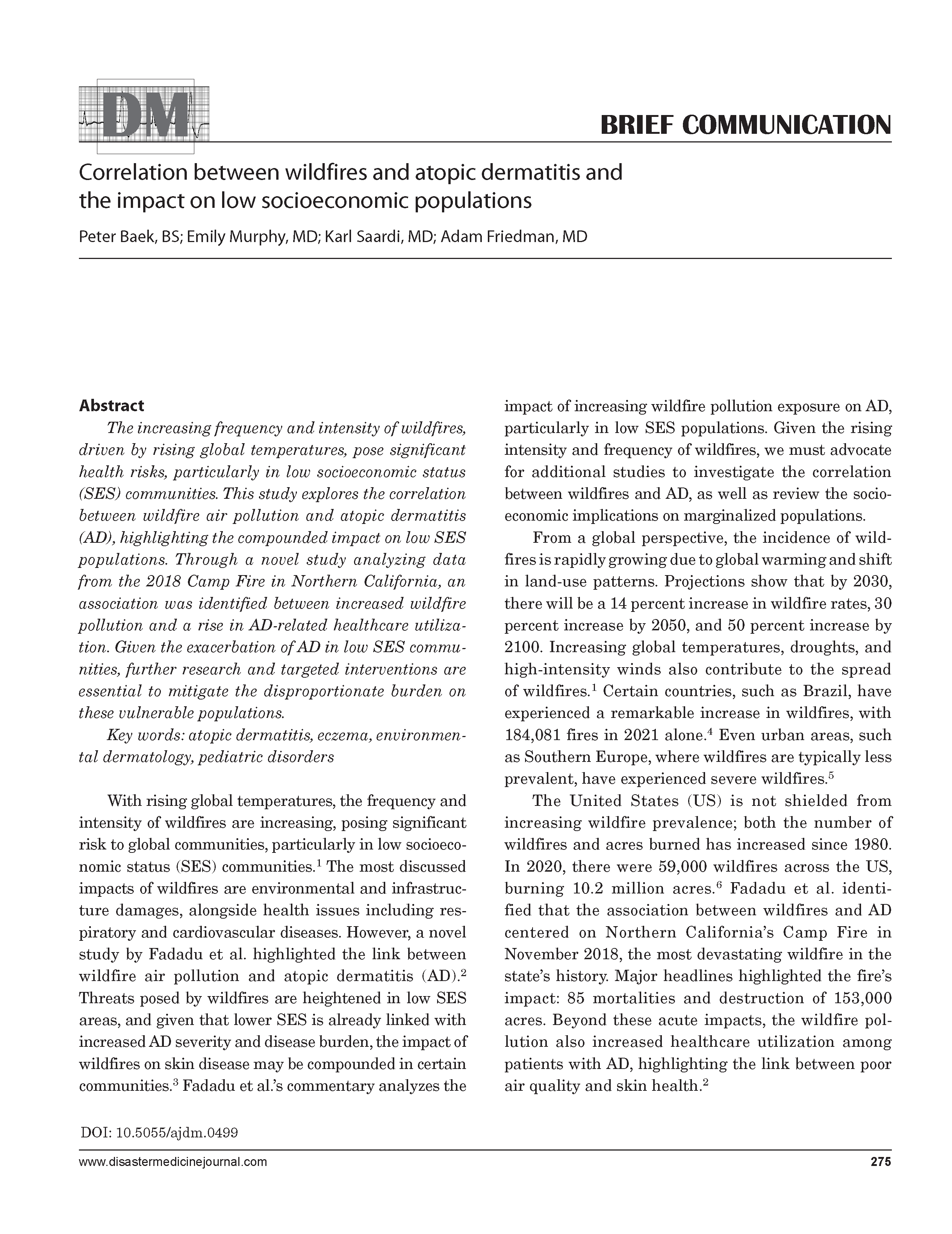Correlation between wildfires and atopic dermatitis and the impact on low socioeconomic populations
DOI:
https://doi.org/10.5055/ajdm.0499Keywords:
atopic dermatitis, eczema, environmental dermatology, pediatric disordersAbstract
The increasing frequency and intensity of wildfires, driven by rising global temperatures, pose significant health risks, particularly in low socioeconomic status (SES) communities. This study explores the correlation between wildfire air pollution and atopic dermatitis (AD), highlighting the compounded impact on low SES populations. Through a novel study analyzing data from the 2018 Camp Fire in Northern California, an association was identified between increased wildfire pollution and a rise in AD-related healthcare utilization. Given the exacerbation of AD in low SES communities, further research and targeted interventions are essential to mitigate the disproportionate burden on these vulnerable populations.
References
United Nations Environment Programme: Spreading like wildfire—The rising threat of extraordinary landscape fires. A UNEP Rapid Response Assessment. 2022. Available at https://www.unep.org/resources/report/spreading-wildfire-rising-threat-extraordinary-landscape-fires. Accessed July 8, 2022.
Fadadu RP, Grimes B, Jewell NP, et al.: Association of wildfire air pollution and health care use for atopic dermatitis and itch. JAMA Dermatol. 2021; 157(6): 658. DOI: 10.1001/jamadermatol.2021.0179. DOI: https://doi.org/10.1001/jamadermatol.2021.0179
Chung J, Simpson EL: The socioeconomics of atopic dermatitis. Ann Allergy Asthma Immunol. 2019; 122(4): 360-366. DOI: 10.1016/j.anai.2018.12.017. DOI: https://doi.org/10.1016/j.anai.2018.12.017
Alves B: Number of wildfires in Brazilian biomes 2021. 2022. Available at https://www.statista.com/statistics/1044209/numberwildfires-brazil-biome/. Accessed July 8, 2022.
Fernandez-Anez N, Krasovskiy A, Müller M, et al.: Current wildland fire patterns and challenges in Europe: A synthesis of national perspectives. Air Soil Water Res. 2021; 14: 117862212110281. DOI: 10.1177/11786221211028185. DOI: https://doi.org/10.1177/11786221211028185
Congressional Research Service: Wildfire statistics. 2022. Available at https://crsreports.congress.gov/product/pdf/IF/IF10244. Accessed July 10, 2022.
Kathuria P, Silverberg JI: Association of pollution and climate with atopic eczema in US children. Pediatr Allergy Immunol. 2016; 27(5): 478-485. DOI: 10.1111/pai.12543. DOI: https://doi.org/10.1111/pai.12543
Lee YL, Su HJ, Sheu HM, et al.: Traffic-related air pollution, climate, and prevalence of eczema in Taiwanese school children. J Invest Dermatol. 2008; 128(10): 2412-2420. DOI: 10.1038/jid.2008.110. DOI: https://doi.org/10.1038/jid.2008.110
Vicente A, Alves C, Calvo AI, et al.: Emission factors and detailed chemical composition of smoke particles from the 2010 wildfire season. Atmos Environ. 2013; 71: 295-303. DOI: 10.1016/j.atmosenv.2013.01.062. DOI: https://doi.org/10.1016/j.atmosenv.2013.01.062
Avena-Woods C: Overview of atopic dermatitis. Am J Manag Care. 2017; 23(8): S115-S123.
Hidaka T, Ogawa E, Kobayashi EH, et al.: The aryl hydrocarbon receptor AhR links atopic dermatitis and air pollution via induction of the neurotrophic factor artemin. Nat Immunol. 2017; 18(1): 64-73. DOI: 10.1038/ni.3614. DOI: https://doi.org/10.1038/ni.3614
Tauchi M, Hida A, Negishi T, et al.: Constitutive expression of aryl hydrocarbon receptor in keratinocytes causes inflammatory skin lesions. Mol Cell Biol. 2005; 25(21): 9360-9368. DOI: 10.1128/MCB.25.21.9360-9368.2005. DOI: https://doi.org/10.1128/MCB.25.21.9360-9368.2005
Chen H, Samet JM, Bromberg PA, et al.: Cardiovascular health impacts of wildfire smoke exposure. Part Fibre Toxicol. 2021; 18(1): 2. DOI: 10.1186/s12989-020-00394-8. DOI: https://doi.org/10.1186/s12989-020-00394-8
Niwa Y, Sumi H, Kawahira K, et al.: Protein oxidative damage in the stratum corneum: Evidence for a link between environmental oxidants and the changing prevalence and nature of atopic dermatitis in Japan. Br J Dermatol. 2003; 149(2): 248-254. DOI: 10.1046/j.1365-2133.2003.05417.x. DOI: https://doi.org/10.1046/j.1365-2133.2003.05417.x
Masri S, Scaduto E, Jin Y, et al.: Disproportionate impacts of wildfires among elderly and low-income communities in California from 2000-2020. Int J Environ Res Public Health. 2021; 18(8): 3921. DOI: 10.3390/ijerph18083921. DOI: https://doi.org/10.3390/ijerph18083921
Paller A, Jaworski JC, Simpson EL, et al.: Major comorbidities of atopic dermatitis: Beyond allergic disorders. Am J Clin Dermatol. 2018; 19(6): 821-838. DOI: 10.1007/s40257-018-0383-4. DOI: https://doi.org/10.1007/s40257-018-0383-4
Suárez AL, Feramisco JD, Koo J, et al.: Psychoneuroimmunology of psychological stress and atopic dermatitis: Pathophysiologic and therapeutic updates. Acta Derm Venereol. 2012; 92(1): 7-15. DOI: 10.2340/00015555-1188. DOI: https://doi.org/10.2340/00015555-1188

Published
How to Cite
Issue
Section
License
Copyright 2007-2025, Weston Medical Publishing, LLC and American Journal of Disaster Medicine. All Rights Reserved.

